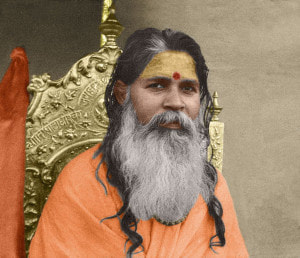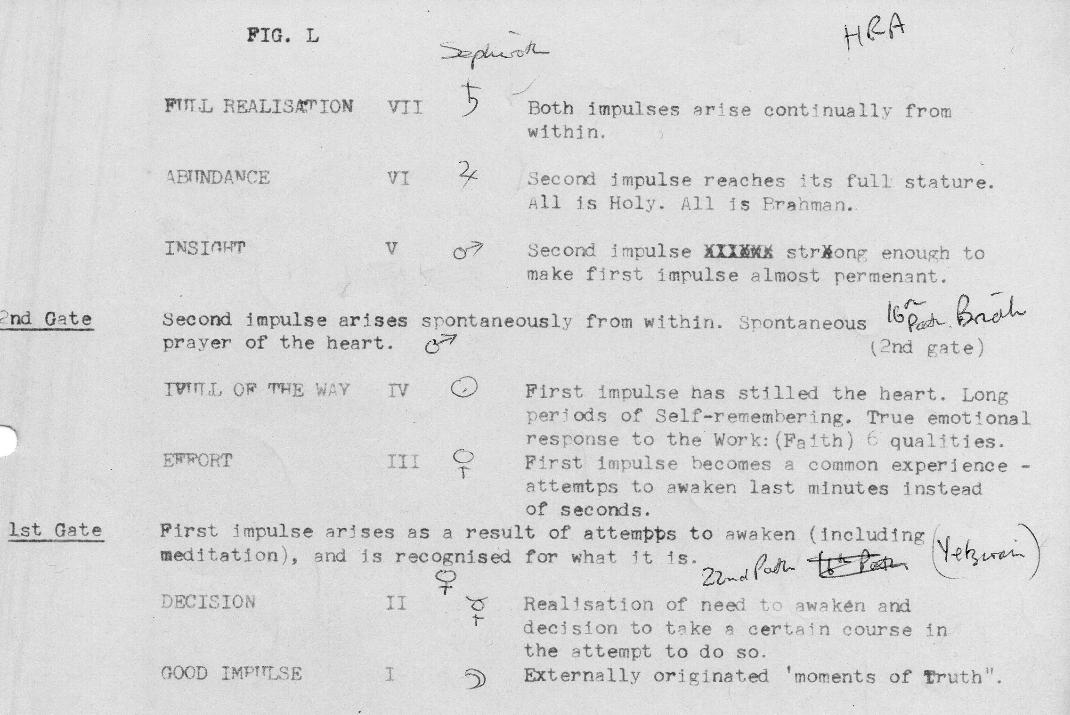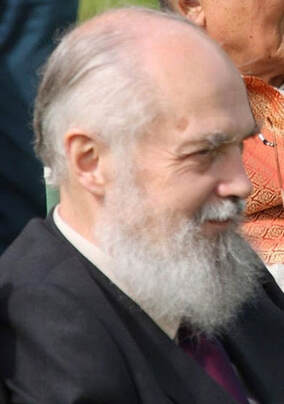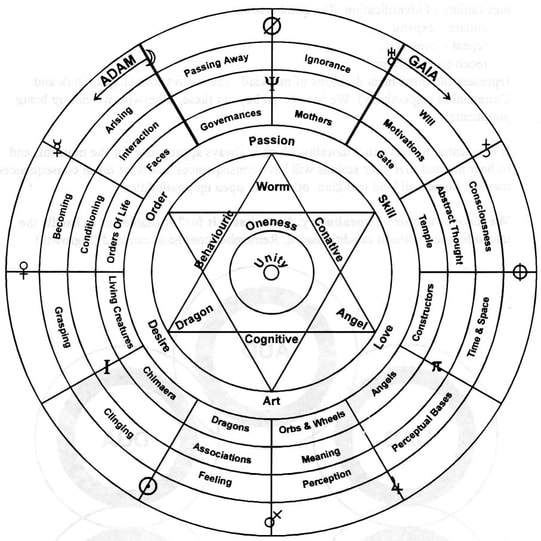|
This article looks at some of the influences from eastern philosophy that fed into the different lines of work of the Soho cabbalists. The three main influences described in the article are Theosophy from the start of the group, then Transcendental Meditation and Advaita Vedanta in the early 1960s and finally the influence of Buddhism on Saros from the late 1960s to the present day. Theosophy At the very beginning of the Soho group of cabbalists, the influence of Eastern Philosophy was present, through the influence of Theosophy. Alan Bain writes: “Students had two mandatory books to purchase and study. This was to ensure that only serious students came in, as no fees were charged. The two books were, The Mystical Qabalah by Dion Fortune, and First Principles of Theosophy by C. Jinarajadasa. They all dreaded the latter owing to its complexity (!) but did as they were asked. The reason was simply that without an understanding of the standard theosophical ideas of the time, students would never properly grasp the later intricacies of Kabbalah, nor would they be able to use it to the full, especially in its ability to act as a means of comparing different "occult" systems. Comparative theosophy if you like.” [1] The Theosophical society had been founded by Helena Blavatsky in 1875, and brought together ideas from philosophies such as neo-platonism, Vedānta, Mahāyāna Buddhism, Kabbalah, and Sufism. The society aimed to act as a bridge between East and West, linking for example Christian and Hindu ideas. Helena Blavatsky, Founder of the Theosophical society Theosophy was not a requirement for later groups, although Alan Bain maintained an interest in it throughout his life, becoming in the late 1990s one of the founders of Theosophy International, an informal grouping of people interested in Theosophy on the internet. First Principles of Theosophy The book that Alan required group members to read, First Principles of Theosophy [2], introduces Theosophical ideas on the evolution of life and the universe. Key concepts are introduced, such as reincarnation and karma, the seven planes of existence and the four bodies of a human being. The role of Adept Brotherhoods in helping human and individual evolution is discussed, as is the evolution of consciousness. Often a link is made between Christian and Indian concepts. For example, the Christian Trinity is equated to the Hindu trinity of Brahma, Vishnu and Shiva. The book also presents some Buddhist ideas such as the “fetters” which “the candidate must cast off one by one, before he can finally come to Adeptship.” [3] These are the mental fetters of Buddhism such as Sakkayaditthi - “the delusion as to one’s individuality or Self”, Vichikichchha – “doubt”, and Silabbataparamasa - “reliance upon rites and ceremonies”. In Theosophy, like Buddhism, the eventual aim is to obtain Nirvana. A diagram from First Principles of Theosophy (p.202), illustrating the scale of consciousness. Dion Fortune and Theosophy Some of the ideas of Theosophy would already be familiar to members of the group – there is an overlap between Theosophy and Kabbalah, and Dion Fortune was herself a member of the Theosophical Society for several years, although she was always rather wary of introducing Eastern ideas into the West. For example in The Mystical Qabalah she says: “The dharma of the West differs from that of the East; is it therefore desirable to try and implant Eastern ideals in a Westerner? Withdrawal from the earth-plane is not his line of progress. The normal, healthy Westerner has no desire to escape from life, his urge is to conquer it and reduce it to order and harmony. It is only the pathological types who long to "cease upon the midnight with no pain," to be free from the wheel of birth and death; the normal Western temperament demands "life, more life." Despite this stance, Dion Fortune takes for granted a number of Eastern concepts such as reincarnation and karma. TM and Advaita Vedanta Another strand of Eastern influence came with the Maharishi in the early 1960s. As discussed earlier, when the Maharishi first came to England bringing Transcendental Meditation (TM), the SES and Study Society saw something that had been missing from the tradition of Ouspensky and Gurdjieff that they had been following. The Soho Cabbalists at that time were also involved, and took up TM for a while. The Shankaracharya of Jyotir Math, His Holiness Shantanand Saraswati Later on Dr Roles, the head of the Study Society established a direct connection with the Shankaracharya, the head of the Maharishi’s tradition. This tradition, Advaita Vedanta, is one of the Hindu Schools of Philosophy, consolidated by Adi Shankara in the 8th century. The Study Society defines Advaita as: “Non-duality or Advaita (not two) is a philosophy of unity consciousness and supporting practices which hold that all is one and that separation is an illusion.” For some people in the Soho Cabbalists this became a continuing connection. For example, in 1970 Robin Amis was advertising ‘Non-Dualist Yoga’ as one of the traditions employed in his ‘Society of the Hidden Life’. Alan Bain’s Kabbalah and Advaita In a 1999 article Alan Bain writes: With Kabbalah, the "individual relations" are with a number or series of teachers spanning centuries of teaching and tradition, or even, for all we know, hundreds of thousands of years. In this, Kabbalah has a special "something" in common with the Hindu followers of the still living Shankaracharya school of philosophy, differing on the surface at least with a number of aspects of that teaching, but below the surface, sharing a strong sense of identity and even perhaps an original origin or source. One interesting connection made by Alan between Advaita and Kabbalah is that of the ‘Ladder of Seven Steps to full Realization’. Dr Roles presented the Shankaracharya’s description of the Ladder of Seven Steps in 1962 [4]. Alan subsequently linked these with the Tree of Life and with the ‘Seven Steps’ in his Keys to Kabbalah [5]. Alan Bain’s notes relating the Ladder of Seven Steps to the Tree of Life. Mantras and Chakras Alan seemed to take against TM and SES after a while, perhaps partially due to the Cabbalists finding they were all given the same mantra for meditation. [6] This led to the Cabbalists finding their own mantras, which correspond to different chakras. In later years, Alan gives a rather more balanced discussion of mantric meditation in his Keys to Kabbalah [7]: “The Indian method of mantric meditation imported into the West by the Maharishi Mahesh Yogi is based on a Hindu mantra related to the solar plexus, and we can see how such a method is intended to work upon a particular centre in order to strengthen it. “We find it useful to know, for instance, that the Hindus have other mantras for other centres, and are thus able to put such methods into perspective in relation to the whole being, an advantage that someone who practices mantric meditation with no other experience than the mystique of an initiation ceremony in Sanskrit does not possess. (Details of these can be found in the Pelican Book, Yoga, by Ernest Wood, p. 152 [8]). This is not to say that such a method of meditation should not be practised - quite the reverse; but it is to say that such practices are more effective when allied to a system of thought, and to a teaching. Sanskrit is the language of the mysteries for the people of the East. For the West, it is the Hebrew of the Old Testament and the Kabbalah, from which tradition Jesus appeared. Having said this, it is also said that all versions of the teaching originates in one source, and that all traditions are branches of one tree. Only good can come out of a marriage of East and West. A glance at both Hebrew and Sanskrit writing still shows traces of what may have been a once common, but long forgotten, language.” Alan Bain’s rough notes placing the Hindu Mantric words on the middle pillar of the Tree of Life according to the chakras. Buddhism and Kabbalah An influence which is still present today is that of Buddhism (particularly in the form of Samatha Meditation) on the line of work started by Glyn Davies, which led to a reformulation of Kabbalah in Saros Philosophy, and later to the enigmatic diagrams of Sareoso. In the late 1960s Glyn Davies met the Buddhist scholar and meditation teacher Lance Cousins through a mutual friend in SES. Lance had been a student of Buddhist Samatha meditation since his undergraduate days in Cambridge, where he had also been introduced to the Kabbalistic Tree of Life. Glyn and Lance began a lifelong friendship which enabled many links between Saros and The Samatha Trust. Lance had first been introduced to Samatha meditation in 1963 when he attended meditation classes given in London by Nai Boonman, a former Thai monk. When the classes finished, Lance, who was then Chairman of the Cambridge University Buddhist Society, invited Nai Boonman to teach in Cambridge which he did from mid-1964. [9] Lance Cousins, 2012 (Photo by Robert Adkins, via Wikimedia) In 1967 Glyn was working towards the establishment of a new Kabbalah group in London, and Lance had recently returned to London after a period working abroad. They first met at a series of talks organised by a mutual friend, and before long were helping each other on various projects. Cherry Gilchrist recalls how Lance first introduced her to the Kabbalistic Tree of Life in 1969 in Cambridge, when she was a final-year student: “He carried a large paper scroll. ‘I decided it was time for a bit of Tree,’ he said, unrolling it on our sitting room floor. (We believed in living at floor level in those days.) The page, when opened, revealed a large geometric diagram. ‘This is the Kabbalistic Tree of Life,’ he said. As he did this, the room seemed to vibrate and I suddenly felt as though I was inhabiting a different dimension. The air itself tingled. I can only explain this as some kind of recognition, and the opening up of a higher state of consciousness; the state persisted for several days afterwards. It was only a black and white drawing with no embellishments, but as Lance explained the meaning of the Sefiroth, something fell into place for me. Perhaps it is not so well-known that Lance was able, in a remarkable way, to span different traditions, and explain them to others, often from first-hand knowledge. It is ironic that he, as a committed Buddhist, was the person who first introduced me to Kabbalah, and that he had the perception to see that it would have significance for me.” [10] Lance took up a teaching post at Manchester University, where he started the Manchester University Buddhist Society. In the early 1970s Lance became one of the founders of the Samatha Trust, and around the same time he helped Glyn to establish a Manchester Kabbalah group which eventually became part of Saros. The membership of the Samatha Trust and Saros overlapped, and both organisations fed into each other. Saros and Samatha have maintained a close relationship over the years. Cherry Gilchrist recalls that the idea of buying a joint centre was considered in the late 70s but didn’t come to fruition, so the organisations maintained their independence. In the last twenty years or so, while Saros has dissolved its formal status, Samatha has increased its presence by establishing several centres in the UK. However, many individuals have belonged to both movements, and have partaken in the activities of each, to varying degrees. Glyn’s own ashes were scattered at the national Samatha Centre at Greenstreete in Wales, in the River Lugg (meaning ‘Bright Stream’). Dependent Origination Lance and Glyn were able to talk about each other’s traditions through their experiences in meditation and self-observation. This enabled Glyn to adapt elements of Buddhist theory for the reformulation of Kabbalah in Saros Philosophy. One example of this is the twelve links of Dependent Origination found in the Buddhist Wheel of Life. The Tibetan Bhavachakra – Wheel of Life The idea of dependent origination is to show the chain of causes which link together to make a cycle of life and death and rebirth. Another way of looking at it is an analysis of what happens with every thought or impulse that arises within us. The twelve links fitted in with Glyn’s thinking on the roots of Astrology, and he adapted it for use with Saros theory and also some of the later Sareoso diagrams. Diagram from the Worm-Dragon-Angel Seminar Report [11], linking dependent origination with Saros Theory and the Kabbalistic Tree of Life via the planetary correspondences. Many of the labels used for the twelve links are immediately recognisable from the Buddhist system (such as 'Grasping' and 'Becoming' for example) but others are changed (for example 'Time & Space' is usually called 'Name & Form' in the Buddhist tradition). The following passage from the Book of Jubilee [12], seems reminiscent to me of Dependent Origination: “Seek the eternal, seek permanence, seek the Mother. Seek endless change, seek impermanence, seek the Father, the One. Seek not either, seek the silence behind the sound, seek the darkness behind the light, seek void, seek to end existence. These three bind consciousness to form. Rod Thorn Notes [1] Alan Bain’s article ‘An Example of Brotherhood’ in Theosophy World http://theos-world.com/tw199807.html#122049800 [2] First Principles of Theosophy by C. Jinarajadasa (Theosophical Publishing House, 1921) is available on line here: https://www.theosophy.world/resource/ebooks/first-principles-theosophy-c-jinarasadasa [3] Jinarajadasa, page 227. [4] Dr Roles presentation of the Shankaracharya’s description of the Ladder of Seven Steps. https://www.ouspenskytoday.org/wp/wp-content/uploads/1962_59.pdf [5] Alan Bain, The Keys to Kabbalah p.40. http://m_euser.tripod.com/articles/keys_to_kabbalah.htm [6] Conjunction: SES and the Study Society http://www.soho-tree.com/blog/conjunction-ses-and-the-study-society [7] Alan Bain, The Keys to Kabbalah p.27. http://m_euser.tripod.com/articles/keys_to_kabbalah.htm [8] Ernest Woods, Yoga (Pelican 1959). The section on mantras associated with the Chakras is on page 152. [9] Samatha Meditation in the UK, https://itipiso.org/uk-samatha.html [10] To Boldly Go: Memories and Inspirations of Lance. (Distributed by Aranstone Books, 2015) [11] Worm-Dragon-Angel Seminar Report (Saros International 1995). http://www.bizworld.co.uk/saros/publications/Word-Dragon-Angel.pdf [12] The Book of Jubilee – A Primer of Saros Philosophy (Cranswick Press, 1984). https://thebookofjubilee.wordpress.com/
0 Comments
Leave a Reply. |
AuthorsArticles are mostly written by Cherry and Rod, with some guest posts. See the bottom of the About page for more. A guide to all previously-posted blogs and their topics on Soho Tree can be found here:
Blog Contents |
Proudly powered by Weebly









 RSS Feed
RSS Feed